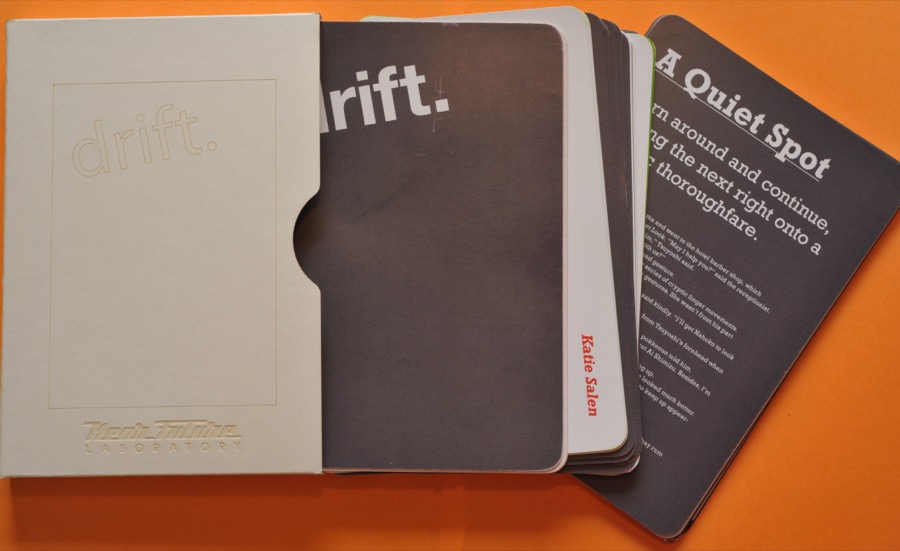
Project Summary
The Drift Deck (Analog Edition) is an algorithmic puzzle game used to navigate city streets. A deck of cards is used as instructions that guide you as you drift about the city. Each card contains an object or situation, followed by a simple action.
The motivation for Drift Deck comes from the Situationist International, which was a small, international group of political and artistic agitators. Formed in 1957, the Situationist International was active in Europe through the 1960s and aspired to major social and political transformations.
Project Semantic Tags
IDEATION CARDSPSYCHOGEOGRAPHYURBAN DESIGN
For Analog Play (batteries not required.)
The Drift Deck (Analog Edition) is an algorithmic puzzle game used to navigate city streets. A deck of cards is used as instructions that guide you as you drift about the city. Each card contains an object or situation, followed by a simple action. For example, a situation might be — you see a fire hydrant, or you come across a pigeon lady. The action is meant to be performed when the object is seen, or when you come across the described situation. For example — take a photograph, or make the next right turn. The cards also contain writerly extras, quotes and inspired words meant to supplement your wandering about the city.
Processed in collaboration with Dawn Lozzi and Mike Kruzeniski who did all of the graphic design.
The motivation for Drift Deck comes from the Situationist International, which was a small, international group of political and artistic agitators. Formed in 1957, the Situationist International was active in Europe through the 1960s and aspired to major social and political transformations.
Originally developed for exhibition/workshopping at the Conflux 2008 Festival, NYC, September 11-14, 2008, and hosted by Center for Architecture located at 536 LaGuardia Place, New York, NY 10012
The motivation for Drift Deck comes from the Situationist International, which was a small, international group of political and artistic agitators. Formed in 1957, the Situationist International was active in Europe through the 1960s and aspired to major social and political transformations.
Guy Debord, one of the major figures in the Situationist International, developed what he called the “Theory of the Dérive.”
“Dérives involve playful-constructive behavior and awareness of psychogeographical effects, and are thus quite different from the classic notions of journey or stroll.
In a dérive one or more persons during a certain period drop their relations, their work and leisure activities, and all their other usual motives for movement and action, and let themselves be drawn by the attractions of the terrain and the encounters they find there. Chance is a less important factor in this activity than one might think: from a dérive point of view cities have psychogeographical contours, with constant currents, fixed points and vortexes that strongly discourage entry into or exit from certain zones.”
Psychogeography was defined in 1955 by Guy Debord as the “the study of the precise laws and specific effects of the geographical environment, consciously organized or not, on the emotions and behavior of individuals.” Psychogeography includes just about anything that takes pedestrians off their predictable paths and jolts them into a new awareness of the urban landscape.” The dérive is considered by many to be one of the more important of these strategies to move one away from predictable behaviors and paths.
http://is.gd/1Gy1
http://en.wikipedia.org/wiki/Dérive
http://en.wikipedia.org/wiki/Psychogeography
The cards will be available for festival visitors to borrow and return for others to use during the Conflux Festival.
Design and Implications by Julian Bleecker and Dawn Lozzi. Creative Assistance and Support from Nicolas Nova, Pascal Wever, Andrew Gartrell, Simon James, Bella Chu, Pawena Thimaporn, Duncan Burns, Raphael Grignani, Jan Chipchase, Tom Arbisi, Mike Kruzeniski and Rob Bellm. Processed for Conflux Festival 2008.
Special Joker Cards featuring compositions by Jane Pinckard, Ben Cerveny, Jane McGonigal, Bruce Sterling, Katie Salen, Ian Bogost and Kevin Slavin. Joker illustrations by Rob Bellm.
Part of a long, proud line of land mapping technologies that includes PDPal, Ubicam Backward Facing Camera and Battleship: Google Earth, and WiFiKu.
Use the Contact Form below to discuss how you can engage Near Future Laboratory to help you make sense of your organization's possible futures.